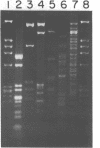Abstract
Two new site-specific endonucleases, N1a III and N1a IV, have been isolated from Neisseria lactamica. N1a III recognizes the sequence, CATG, and cleaves 3' of the sequence to produce a four base 3' extension. N1a IV recognizes the sequence, GGNNCC, and cleaves between the two N's to produce blunt ended fragments.
Full text
PDF








Images in this article
Selected References
These references are in PubMed. This may not be the complete list of references from this article.
- Brown N. L., Hutchison C. A., 3rd, Smith M. The specific non-symmetrical sequence recognized by restriction endonuclease MboII. J Mol Biol. 1980 Jun 15;140(1):143–148. doi: 10.1016/0022-2836(80)90360-5. [DOI] [PubMed] [Google Scholar]
- Brown N. L., Smith M. Cleavage specificity of the restriction endonuclease isolated from Haemophilus gallinarum (Hga I). Proc Natl Acad Sci U S A. 1977 Aug;74(8):3213–3216. doi: 10.1073/pnas.74.8.3213. [DOI] [PMC free article] [PubMed] [Google Scholar]
- Fuchs C., Rosenvold E. C., Honigman A., Szybalski W. Identification of palindromic sequences recognized by restriction endonucleases, as based on the tabularized sequencing data for seven viral and plasmid DNAs. Gene. 1980 Sep;10(4):357–370. doi: 10.1016/0378-1119(80)90156-0. [DOI] [PubMed] [Google Scholar]
- Fuchs L. Y., Covarrubias L., Escalante L., Sanchez S., Bolivar F. Characterization of a site-specific restriction endonuclease SphI from Streptomyces phaeochromogenes. Gene. 1980 Jun;10(1):39–46. doi: 10.1016/0378-1119(80)90141-9. [DOI] [PubMed] [Google Scholar]
- Gingeras T. R., Greenough L., Schildkraut I., Roberts R. J. Two new restriction endonucleases from Proteus vulgaris. Nucleic Acids Res. 1981 Sep 25;9(18):4525–4536. doi: 10.1093/nar/9.18.4525. [DOI] [PMC free article] [PubMed] [Google Scholar]
- Korch C., Hagblom P., Normark S. Sequence-specific DNA modification in Neisseria gonorrhoeae. J Bacteriol. 1983 Sep;155(3):1324–1332. doi: 10.1128/jb.155.3.1324-1332.1983. [DOI] [PMC free article] [PubMed] [Google Scholar]
- Roberts R. J. Restriction and modification enzymes and their recognition sequences. Nucleic Acids Res. 1985;13 (Suppl):r165–r200. doi: 10.1093/nar/13.suppl.r165. [DOI] [PMC free article] [PubMed] [Google Scholar]
- Sanger F., Nicklen S., Coulson A. R. DNA sequencing with chain-terminating inhibitors. Proc Natl Acad Sci U S A. 1977 Dec;74(12):5463–5467. doi: 10.1073/pnas.74.12.5463. [DOI] [PMC free article] [PubMed] [Google Scholar]
- Tu C. P., Wu R. Sequence analysis of short DNA fragments. Methods Enzymol. 1980;65(1):620–638. [PubMed] [Google Scholar]









